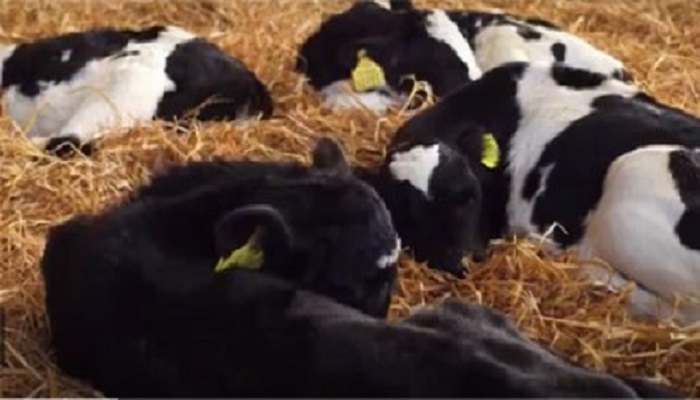31 January 2024
Keeping calves healthy as calf rearing kicks off

In recent years over four hundred thousand calves are traded annually between dairy and beef farmers around the country. With calving in full swing on dairy farms, the coming weeks will see large numbers of calves move between both enterprises. Tommy Cox tells us how to keep calves healthy.
One area fundamental to successful dairy calf to beef enterprises is buying a healthy animal with genetic potential to perform well from birth right through to slaughter. From purchase until the calf is weaned off milk, is one of the most crucial periods for the calf-to-beef enterprise. The growth rate achieved during these next few months will affect the lifetime performance of the animal, therefore keeping the animal healthy is important to ensure full genetic potential for growth and feed conversion efficiency is obtained.
There are numerous challenges to calf health in the early stages of the animal’s life with pneumonia and scour being two of the predominant causes of illness.
Purchasing calves
Taking a proactive and preventative approach to herd health is the key in successful dairy–beef systems. Successful herd health planning should start before the calves land on farm. Research shows that purchasing calves from a greater number of sources increases the risk of calf health problems, therefore minimizing the number of sources from which calves are purchased, while also ensuring farms of high-health status and high levels of calf welfare are selected is important, as this will reduce the risk of bringing disease onto the farm.
Providing the correct environment is a fundamental aspect of keeping stock healthy. Once calves arrive on farm it is important they enter an environment which will not compromise their health. Housing needs to be well ventilated to ensure air is fresh but also designed so no draughts are created. Calf housing needs to be dry with a good drainage system as calves spend 80% of their time lying down so they need a dry bed. Regular cleaning and disinfection of all areas used by calves is important to keep bacteria which would bring the onset of scour from building up.
Preventing scour
The first three weeks in a calf’s life is usually the danger period for scour. A variety of infectious organisms can cause calf scours, including rotavirus, coronavirus, E. coli, cryptosporidia, coccidia and Salmonella species. Most of these organisms will generally occur in the first three weeks of the calfs life. By sourcing calves that are a minimum of three weeks of age, this will greatly reduce the chance of scour outbreaks occurring on farm. These three week old calves should be sourced from dairy farmers where best practice with regard to colostrum and hygiene is practiced. At this age calves will have come through the danger period for scour and even if they do get a scour they will more than likely be able to overcome it.
Dealing with dehydration
On arrival, all calves should be checked to see if they are dehydrated by using the skin pinch method. If the skin on the calf is slow to snap back in place, feed the calf with two litres of electrolyte and water. Electrolytes should not be mixed in milk.
Treatment for coccidiosis
If buying calves from multiple sources or if there is history of coccidiosis on your farm, a preventive treatment for coccidiosis is advisable. At between 3-6 weeks of age calves are particularly vulnerable to coccidiosis. Infection can result in watery faeces which can slow growth rates and lead to failure of calves to wean at their optimal age and weight. On certain farms a second coccidosis treatment will need be given when calves are at grass.
The importance of preventing pneumonia
Pneumonia is the most common disease associated with housed calves. Mortality rates due to pneumonia are approximately 3% in calves in the first 12 weeks of life. The cost of treatment, loss in performance and time cost due to pneumonia can heavily reduce farm efficiency and profits. Cattle affected by pneumonia earlier in life take two months longer to finish and even cattle exposed to pneumonia but not visibly affected may take one month longer to finish. Many of the infectious agents commonly involved in calf pneumonia are actually present in healthy calves and in other livestock on farms without causing pneumonia outbreaks. However, these agents can cause pneumonia if the calfs immune system is compromised. Factors such as nutrition, colostrum intake, housing, hygiene, ventilation, overcrowding and stress all contribute.
Currently available vaccines protect against lungworm, IBR, RSV, PI3, Mannheimia haemolytica and Histophilus somni. While vaccines do reduce the level of mortality and production levels associated with pneumonia in calves, it will not eliminate pneumonia if management factors such as nutrition, colostrum intake, housing hygiene, ventilation and stress are not correct.
